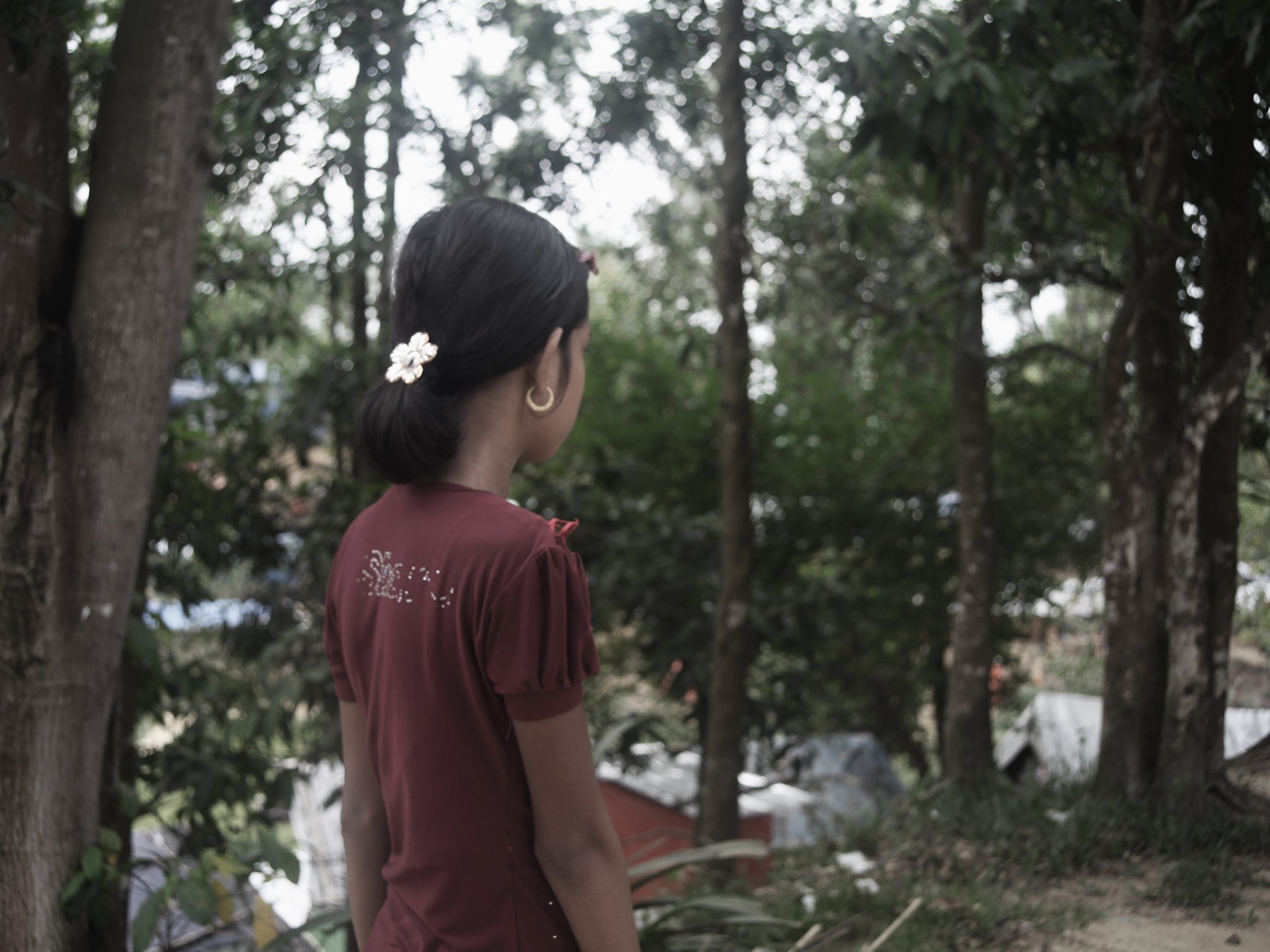Traumatised Rohingya Muslim children describe the horrors they have witnessed fleeing Burma
Exclusive: Kurshida, 12, watched through a bamboo wall as the men of her village were slaughtered ‘like chickens’. Speaking to The Independent from the safety of a refugee camp in Bangladesh, hers is one of a growing body of accounts of the horror across the border in Rakhine state

Sitting in a rare clearing in the crowded Balukhali refugee camp, little Kurshida* clutches the sides of her wooden chair. “When they slaughtered them, it sounded like a chicken being killed,” she says quietly.
At just 12 years old, she witnessed up close the mass slaughter of her community in a village in Buthidaung Township, in Burma’s western Rakhine state.
Up to 100 people may have been killed, but there is currently no way of knowing for sure. Kurshida’s village is being kept secret to protect her identity, because of the risk of retribution if she ever returns home.
“They were shooting our neighbours all day,” she says. The army is believed to have come to her village as part of a large-scale Burmese military operation, which has been likened to a “textbook example of ethnic cleansing” by the UN.
Burma’s government claimed it was conducting a security operation against Rohingya militants. This could be why just the men in Kurshida’s village were targeted, unusually, for a conflict where there have been so many accounts of gender-based violence.
The Burmese government has denied any abuses. The military, known as the Tatmadaw, cleared itself of any wrongdoing in an internal investigation, saying there were “no deaths of innocent people”.
But Kurshida’s account suggests otherwise. Her community was hiding in a large house when the soldiers arrived, Kurshida says, but they were discovered. The men and women were separated to adjacent rooms, and the soldiers began slaughtering the men indiscriminately.
Kurshida peered through a hole in the bamboo wall in the house to see the horror unfold next door. Some men were being shot by soldiers. Others met a different death. “They put them in masks, tied their hands and…” Kurshida draws her hand across her throat.
Their bodies were dumped outside in a courtyard.
While Kurshida cried, the other women around her recited the Koran. The only family member with her was her aunt, with whom she later fled to Bangladesh.
It isn’t clear what happened to her father. Kurshida, evidently still shaken by her experience, tells The Independent he was one of the men whose throat was cut by troops. Her uncle, who had escaped the village before, says her mind has become mixed up in the chaos, and her father was shot dead beside him as they fled the soldiers.
Kurshida has been severely traumatised, according to Zahidul Islam, a psychologist who is working with her. “When she first came here, she just cried all the time,” he says. “She can get better, but she needs a lot more work.”
Kurshida is one of hundreds of thousands of Rohingya children who have been forced from their homes as a result of extreme violence, and left highly vulnerable in overcrowded refugee camps in southern Bangladesh.
Her testimony is not unique, and all the more concerning for that reason. A number of other harrowing accounts have been documented in a Save The Children report, released on Thursday, entitled “Horrors I will never forget: The stories of Rohingya children”. It describes how other children like Kurshida, who did not make it to the relative safety of Bangladesh, were raped, killed or burned alive.
And the trauma for Rohingya children did not just in their villages.
Toyaba*, also just 12, says she and her family stayed inside their home for six days as the sounds of gunshots and rockets grew closer through the jungle.
“It went Boom! Boom! Boom!” says Toyaba’s mother, Sobika*, 28. “I heard the sound of fighting and was scared it would be me next.”
Then a rocket was launched from a nearby hilltop and the family home was set ablaze. They fled with nothing.
It is a journey that Toyaba will never forget. She lost all her toenails and her legs swelled up as she fled her village, trying to reach the border.
“It was very difficult,” she says. “I had to take the walk tree by tree. We drank rainwater from puddles and ate leaves. It will be in my mind for the rest of my life.”
Rohingya refugees – in pictures
Show all 15Among the worst horrors Toyaba witnessed were on the path to Bangladesh. “I saw dead bodies in a paddy field on the way,” she says. “I also saw the bodies of children who died on the road. I was scared the same would happen to me.”
Rumours constantly circulated among the fleeing Rohingya, fuelling the anxiety that the military was coming to get them. Other refugees The Independent spoke to believed they had made the long journey safely, only to be shot at by Burmese troops near the border.
The family eventually made it to the Naf river, bordering Bangladesh, and crossed in a boat. They have been living in the sweltering Balukhali camp for around two months.
Toyaba’s mother Sobika says they will never return to Burma, she would rather eat leaves in the jungle again. But she feels more secure in the camp, now that no one is trying to kill her family.
Meanwhile, Kurshida, despite her experiences, misses home.
“I want to go back to Burma,” she says. “It’s not good here, it’s too hot, and it makes me sick. If the people go back there, I will go with them.”
*Names changed to protect the children’s identities
Subscribe to Independent Premium to bookmark this article
Want to bookmark your favourite articles and stories to read or reference later? Start your Independent Premium subscription today.

Join our commenting forum
Join thought-provoking conversations, follow other Independent readers and see their replies